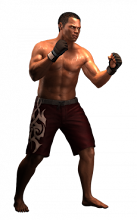The modern boxing stance differs substantially from the typical boxing stances of the 19th and early 20th centuries. The modern stance has a more upright vertical-armed guard, as opposed to the more horizontal, knuckles-facing-forward guard adopted by early 20th century hook users such as Jack Johnson.
 |
| Jack Johnson Boxer |
In a fully upright stance, the boxer stands with the legs shoulder-width apart and the rear foot a half-step behind the lead foot. Right-handed or orthodox boxers lead with the left foot and fist. Both feet are parallel, and the right heel is off the ground. The lead (left) fist is held vertically about six inches in front of the face at eye level. The rear (right) fist is held beside the chin and the elbow tucked against the ribcage to protect the body. The chin is tucked into the chest to avoid punches to the jaw which commonly cause knock-outs and is often kept slightly offcenter. Wrists are slightly bent to avoid damage when punching and the elbows are kept tucked in to protect the ribcage. Some boxers fight from a crouch, leaning forward and keeping their feet closer together. The stance described is considered the "textbook" stance and fighters are encouraged to change it around once its been mastered as a base. Case in point, many fast fighters have their hands down and have almost exaggerated footwork, while brawlers or bully fighters tend to slowly stalk their opponents.
Left-handed or southpaw fighters use a mirror image of the orthodox stance, which can create problems for orthodox fighters unaccustomed to receiving jabs, hooks, or crosses from the opposite side. The southpaw stance, conversely, is vulnerable to a straight right hand.
North American fighters tend to favor a more balanced stance, facing the opponent almost squarely, while many European fighters stand with their torso turned more to the side. The positioning of the hands may also vary, as some fighters prefer to have both hands raised in front of the face, risking exposure to body shots.
Modern boxers can sometimes be seen tapping their cheeks or foreheads with their fists in order to remind themselves to keep their hands up (which becomes difficult during long bouts). Boxers are taught to push off with their feet in order to move effectively. Forward motion involves lifting the lead leg and pushing with the rear leg. Rearward motion involves lifting the rear leg and pushing with the lead leg. During lateral motion the leg in the direction of the movement moves first while the opposite leg provides the force needed to move the body.
Source: http://en.wikipedia.org/wiki/Boxing
MMA Pro Fighter








